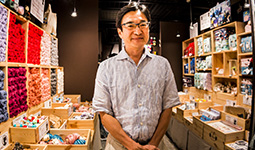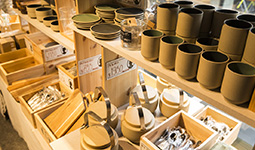Home > Highlighting JAPAN > Highlighting Japan October 2017 > Investing in Japan
Highlighting JAPAN


Lifestyle Brand Launched from Denmark
An established sundry goods brand from Denmark is expanding outside Europe and growing in popularity in Japan.
Northern European-designed furniture, plateware and sundry goods characterized by simple form and cozy colors are popular in Japan, with many stores from small sundries shops in towns to department stores in large cities now handing the products. Søstrene Grene, a Danish sundries company, opened its first shop in Japan in October 2016 in Tokyo’s Omotesando, an area well known for its famous Japanese and international brand outlets.
Søstrene Grene was established in 1973 in Aarhus, Denmark’s second-largest city after capital Copenhagen, and now has more than 150 outlets, mainly in Europe. The company, whose name means “Grene sisters” in Danish, operates based on the concept that it is a shop where the Grene sisters Anna and Clara introduce wonderful items they have found by traveling around the world, thinking that they are “able to find beauty and happiness in even the smallest of things.”
“It is characterized by a rich lineup of Northern European-designed products at a reasonable price and the provision of new products every week. The atmosphere of its products and shops are basically consistent around the world,” says Tsuyoshi Monden, the Representative Director of Hilmer Japan Co., which operates Søstrene Grene in Japan. Hilmer Japan Co. made strategic plans by utilizing the charge-free business infrastructure provided by the Invest Japan Business Support Center (IBSC) of Japan External Trade Organization (JETRO) in the preparatory stage of establishing a Japanese corporation in May 2016.
Inside the shop, against a background of soft classical music, products that “create little, bright differences in the everyday” such as furniture, plateware, kitchenware and stationery are on display. All the products are designed in the head office of Søstrene Grene in Denmark, and emanate a sense of simple and gentle warmth. Various materials and tools such as wrapping items for gifts, interior goods and craft goods are also available. These products are put on wooden shelves or in wooden boxes, which together with the restrained lighting makes for a relaxed atmosphere.
The first shop opened in Omotesando, a popular destination for women, targeting chiefly women in their 30s and 40s, and is generating a buzz with its impressive lineup of kitchenware, furniture and storage boxes. Partly because it is the first outlet of Søstrene Grene in Asia, many tourists visiting Japan from Asian countries also visit the shop.
“Because consumers have a very high consciousness of quality in Japan, we might say that if a product sells well in Japan, it can be accepted in any market in the world. Japan is a foothold, so to speak, for advancement into the Asian market,” says Monden.
This year Søstrene Grene has opened a new shop in Odaiba, a tourist spot in the Tokyo seaside area, and Kichijoji in Musashino City, Tokyo, which is popular particularly among young women. This reflects the company’s strategy of expanding new store openings in Japan, with its eyes on development in Asia.
Along with this, Hilmer Japan is also accelerating its publicity activities using social media for brand penetration in Japan. The transmission of product information news and DIY ideas through its official account on LINE, a free app with more than 70 million monthly active users, is one of its publicity activities.
Unique projects, events and campaigns of each shop, which are transmitted via social media, are also gaining popularity. For example, it is said that when the Odaiba shop ran a campaign to present wooden boxes used for in-store display to customers who have purchased its products exceeding a certain value, it quickly ran out of stock. The shoppers probably felt the “world view of Søstrene Grene” in the set of products and wooden boxes.
Søstrene Grene has developed a business model of focusing on a selection of goods that will encourage local residents to drop by and replacing products regularly. Since this strategy has been a success in the shop in Kichijoji, which is very popular as a “place people want to live,” the shop has acquired many stable repeat customers among the local residents.
Monden says, “Compared with existing sundry stores in Japan, Søstrene Grene outlets are large and have a very large lineup of products. The ability to constantly provide new products is also strong. In Japan, there is an image that Northern European sundry goods are expensive, but our customers are pleased with our products, saying that the prices are ‘reasonable.’”
In November 2017, Søstrene Grene will open a new store in a shopping mall in the suburbs of Nagoya City, Aichi Prefecture. The company aims to make a success of store openings in places other than Tokyo that lead it to the opening of more shops in Japan.
© 2009 Cabinet Office, Government of Japan









